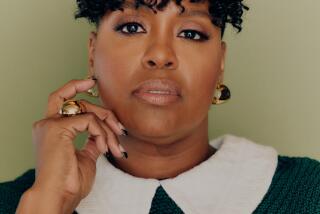Narration can get a bad rap. For these stories, it’s a truth portal into a character
“When I realized that the way to do ‘Atypical’ properly was to do it from Sam’s point of view, I got so mad at myself, because I knew it was going to be challenging and I knew I wanted to do it right,” says “Atypical” creator Robia Rashid. “Because Sam has trouble saying what’s in his head — so having voice-over really helped us to ‘get’ him.”
Voice-over narration is a tricky stylistic choice; it gets dunned for being a “tell not show” form of storytelling, and doesn’t often work. But series including “Atypical,” “The Goldbergs,” “Why Women Kill,” “High Fidelity,” “black-ish,” “The Handmaid’s Tale,” “Mr. Robot,” “Batwoman” and “You” all prove that done right, voice-over can be a poignant, intimate shortcut to getting into a key character’s head.
Several shows use it for characters who are a little left-of-center or closed off to their wider world. “Atypical’s” Sam is on the autism spectrum, so it helps the audience hear him beyond the “weirdo” he says his peers see. “You’s” Joe, however, is a sociopath — and the audience is in on how what he says and what he thinks are at odds.
“I don’t think the show would work without the voice-over,” says “You” showrunner Sera Gamble. “Without it, the audience wouldn’t trust him or feel his experience. It would be a show about a really quiet guy who’s well spoken, and every once in a while he reaches for a hammer and bangs some douchebag on the head.”
Five seasoned entertainment journalists predict the shows and performances the Television Academy will honor with Emmys; do you agree with their picks?
“Mr. Robot‘s” Elliot was anti-social, an unreliable narrator and addressed his audience directly from the first episode as “friend.” But creator Sam Esmail says he knew he had to tread lightly in using so many devices to give the audience access to his mind.
“You can fall into a trap, using voice-over as an expository tool to dish out information, but where it’s really dynamic is when it creates another dimension of the story you’re trying to tell,” he says. “Using his stream-of-consciousness voice-over creates an intimate bond between the main character and the audience.”

Trailer for Hulu’s “High Fidelity”
On “High Fidelity,” the emotionally closed-off Rob breaks the fourth wall too, using the camera like a “confessional,” as Sarah Kucserka (co-showrunner with Veronica West) explains, adding that it’s a more powerful choice than mere voice-over. “It’s the difference between a phone call and a text message,” she says. “You can misread the intent of a voice-over. That’s more difficult to do when you see a character acting out what they’re telling you.”
Curiously, despite the more intimate bond being forged between character and audience, writers frequently point out that the voice inside their characters’ heads may not be totally reliable. Joe in “You” is lying to himself and so lying to the audience; Elliot has mental issues that may be affecting how he perceives reality.

https://www.youtube.com/watch?v=xXBTImqyeU0
But Marc Cherry, who uses various types of voice-over in his “Why Women Kill” series, says he actually likes an all-knowing narrator like the one he used on “Desperate Housewives,” which was inspired by “Sunset Boulevard” — because that narrator is deceased.
“I prefer the omniscient voice that has knowledge and insight into everyone on the show,” he says. “It’s like writing poetry; every single word matters. But you have to make sure that narrator has a point of view in their voice. It sets a tone so you can get the story going efficiently.”
Efficiency is doubly important with shortened broadcast time blocks, which led in part to “Batwoman” using two forms of voice-over: Kathy Kane’s internal monologue expressed in letters and Rachel Maddow‘s voice as Vesper Fairchild, commenting on Gotham’s mood and latest news. “To be honest, we only have so much screen time, so it’s our way of getting a quick temperature and vibe of the city,” says showrunner Caroline Dries.

The cast and crew of ABC’s “black-ish” discuss issues of identity.
Sitcoms have even less space to play around with. “You’re always looking for tools to shortcut the process, because you only have 20, 21 minutes,” agrees “black-ish” showrunner Courtney Lilly, who frequently uses Dre’s (Anthony Anderson) voice to catch viewers up or provide insight. “Being in someone’s head is a benefit.”
Having the option of voice-over can also help avoid reshoots, says “The Goldbergs”/”Schooled” executive producer Doug Robinson. “You can write it in the edit bay if you find out something’s not working or you didn’t land the emotion the first time. You can just have [the voice-over actors] come in and record it and get exactly what you want.”
In the end, though, as “The Handmaid’s Tale” creator/showrunner Bruce Miller says, voice-over is just one key tool a writer has in his toolbox. “We don’t have many elements to use on television — just picture and sound,” he says.
“Ignoring sound means you’re only giving your audience half of what you could. As a writer, you decide what’s best for the story. And sometimes, that’s exactly what voice-over is.”
More to Read
The complete guide to home viewing
Get Screen Gab for everything about the TV shows and streaming movies everyone’s talking about.
You may occasionally receive promotional content from the Los Angeles Times.






